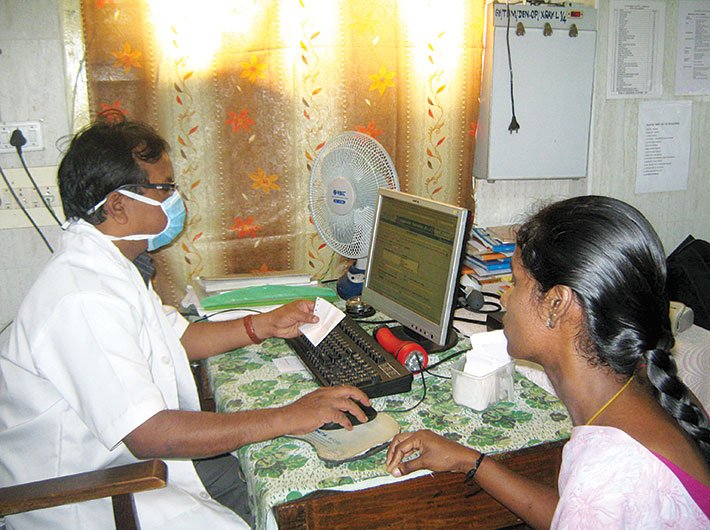By digitising patient information and maintaining it in a searchable repository Tamil Nadu has shown how the efficiency of the public health system can be increased manifold
Fifty-two-year-old Kumar has seen a lot of queues in his life. The diabetic is now happy that at least one has disappeared from his life. When he visits the Tambaram taluk government hospital at Chrompet in Chennai for his monthly check-up, he walks in with a computer-generated slip card that contains his medical history. “What used to take hours now only takes minutes,” said Kumar. “My doctor has complete access to my case history and his consultations are quick and pointed.” Six years ago Kumar had to wait endlessly for the doctor and his medicines. “At times when I forgot to bring prescriptions I had to narrate my medical history to the doctor. Even at the registration counter all my details were noted down afresh,” he recalled. “There were other problems too. Often, after reaching pharmacist, I was told that the particular medicine is out of stock. I had to ask the doctor for an alternative medicine and again stand in the queue to see him.”
Fatima, 55, is also heaving a huge sigh of relief after the implementation of the new system. It has made her frequent dental visits for root canal therapy and extractions easy and simple. “She is carrying the slip that has a unique patient identification number (PIN) issued by the hospital. It has all her other details. Her name is already registered so we need not register the old patients again,” said Radhakrishna, who mans the computerised system. “Earlier when there was manual system there used to be errors in writing the names of the patients. Now the patients come and I feed their details in the computer and hand them over the printed slip. With this system in place, I am able to issue outpatients slips to five patients while earlier I could write and give slips to just one patient in the same time period,” he recounted.
Such transformation is the result of implementation of the health management information system (HMIS), which is the initiative of the state government’s Tamil Nadu Health Systems Project (TNHSP). The TNHSP came into existence in 2005 to improve the health delivery systems. The HMIS is its flagship programme and its total cost is '212 crore. As part of the HMIS, funded by the state and World Bank, all government hospitals in the state are digitising patient records. The project has already been implemented in phases at primary and secondary health centres. It is now being implemented in district-level hospitals.
The HMIS applications have two parts: health management system and management information system (MIS). The health management system includes patient services like registration, diagnosis, medicines, disposable syringes and other hospital-related services. It also has data on trends in diseases that help in research and policy making to address the issues. Under the MIS, the service records of people working in medical institutions across the state, including state-run medical colleges and their hospitals, are available. This system covers doctors, nurses, paramedical and hospital workers and other government staff.
So how does the system work at the ground level? When a patient walks into the hospital, he or she is given a slip that contains name, age, gender and the patient identification number (PIN). When the patient visits doctor, he enters the PIN and other patient related data in the computer system. This is a permanent record of the patient and each consultation report is noted directly into the system. The prescription, advice and date of review are also entered in the record. The examining doctor then can source a patient’s medical history, medicines prescribed and treatment recommended at the click of a mouse. The only thing a patient needs to do is to carry the 16-digit PIN whenever he or she visits the hospital. Using the PIN given to them the patients can visit hospital within the state and can get the examination done.
Further, the doctor can create customised kits of medicines that he can prescribe for specific patients. “He can see availability and non-availability of drugs in the pharmacy and prescribe medicines accordingly,” explained Dr Jayaraman, who is a dentist and the nodal officer of the system at the Tambaram hospital. “With this system, the number of patients I examine in a day has also gone up.” The data also helps the doctors know which of the diseases needs immediate attention. Other details like which age groups are affected with a particular disease, number of births, deaths and suicides help in census and socioeconomic surveys. There is also a bio-medical waste management in place. “We get data like how much plastic waste is generated and how much is infected waste,” pointed out Dr Jayaraman. Every single activity is centralised, and the data gets captured at TNHSP head office in Chennai. Data can always be retrieved if the system gets corrupted at the doctor’s end.
Nurse Maraammal, who has been working in the Tambaram hospital for 22 years, finds the change and efficiency agreeable. “Life at the hospital has become very easy. When a doctor prescribes an injection to a patient, the details of the injection gets displayed on the screen of the computer provided to us. We just need to enter the PIN and can view the prescription and then give injection to the patient. It saves a lot of time. Earlier we had to maintain too many registers. Today, all details of the patients are updated on real time basis: the diet, injections, medicines due, transfer between wards and discharge dates. All this information can be accessed in the system,” she said.
Pharmacist Bhaskar is also happy as he does not have to give dedicated time for stock maintenance. “Earlier it took nearly one hour to manually calculate and maintain stock position,” he said. At the pharmacist counter when a patient’s PIN is entered the prescription appears on screen of the computer. There is an automatic indent in the pharmacy module alerting the main store on the need to stock up the medicines. Drug stocks are updated every time a drug is issued. The pharmacist can monitor the expiry dates and batch number of each drug.
For chief medical officer Dr Sundari, monitoring the performance of doctors has become very simple. “Just at the click of a mouse I can go through performance of any doctor; how many patients a doctor has examined in OP, whether the doctor came in on time. Further, drug audit has become easier. I am even able to analyse prescription pattern and the pilferage has also come down,” said the CMO.
The Royapettah government hospital, a tertiary hospital in Chennai, is still busy adjusting to the new system. ENT specialist Dr Rajshekhar finds it better to write the prescription than updating it online. He complains of connectivity issues that often slow down the system. Electronics Corporation of Tamil Nadu Limited (ELCOT) managing director Atul Anand said that dedicated lines are being provided. “We are also working on upgrading the local area network. Together they should take care of connectivity and bandwidth problems,” he said. ELCOT is the procurement agency for the project.
Officials from Gujarat, Punjab, Uttarakhand, Karnataka and Madhya Pradesh have all trekked to Tamil Nadu to pick up tips on handling HMIS. The system is getting replicated in other states. What makes Tamil Nadu’s initiative unique is that there are no data operators to handle the system, that is, no additional manpower has been deployed to make the HMIS work. The doctors, nurses, pharmacists and lab technicians enter the data.
“Changing the mindset of people was the biggest challenge for us in implementing this system,” said HMIS deputy director Dr SK Thirunavukkarasu. “People used to feel such systems can work only in banks and educational system and not in hospitals. But we have done it. In November 2008 we started the project and now other states are replicating it. They are not, however, doing it in such a wide scale. Since we are in the final phase of the project, which will be completed by 2015, we are now sensitising deans of tertiary care hospitals,” he added.
There is a plan to create state health data resource centre (SHDRC) at the head office, which will be a central repository of data from all tertiary, secondary and primary health care facilities in the state. The SHDRC will be capable of processing institution-wise data available through HMIS and providing information for decision making, data monitoring and evaluation at different levels.

